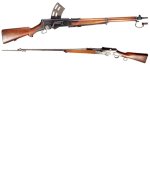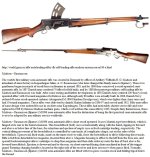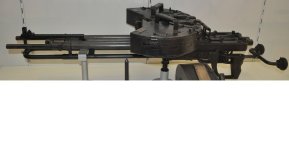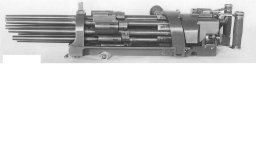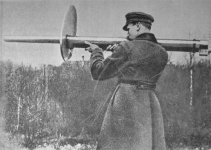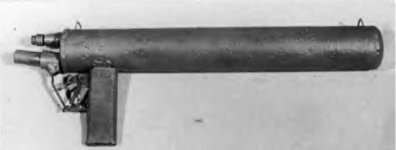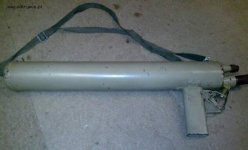You are using an out of date browser. It may not display this or other websites correctly.
You should upgrade or use an alternative browser.
You should upgrade or use an alternative browser.
What the heck
- Thread starter Ozzieman
- Start date
Close
# 100 Woodhull carbine
Woodhull carbine
This rifle was submitted to the Light Rifle trials by the Woodhull Corporation of Millington New Jersey. It was largely copies from the Winchester model 1905 self-loader, and used the same received, bolt, and trigger assembly. It was a straight blowback design, and did not fare well in the trials.
The rifle weighed in at 5.5 pounds with a sling and 5-round magazine. It had a 17.25 inch barrel and an OAL of 29.8 inches. Despite the simple operating principle, it was a fairly complex in design, and suffered numerous ruptured cases and failures to extract. The examiners found it to have poor accuracy, heavy recoil, poor reliability, and difficult to operate manually or disassemble.
Woodhull made several improvements to the gun and resubmitted it for further testing in August 1941. It functioned much more reliably with these changes, which consisted mainly of hardening the barrel to allow a finer polish to the chamber. This solved most of the reliability problems, but the testers feared that once the chamber became worn the rifle would start malfunctioning again. It was dropped from the program after the primary trials.
http://www.forgottenweapons.com/light-rifle-program/woodhull-carbine/
# 100 Woodhull carbine
Woodhull carbine
This rifle was submitted to the Light Rifle trials by the Woodhull Corporation of Millington New Jersey. It was largely copies from the Winchester model 1905 self-loader, and used the same received, bolt, and trigger assembly. It was a straight blowback design, and did not fare well in the trials.
The rifle weighed in at 5.5 pounds with a sling and 5-round magazine. It had a 17.25 inch barrel and an OAL of 29.8 inches. Despite the simple operating principle, it was a fairly complex in design, and suffered numerous ruptured cases and failures to extract. The examiners found it to have poor accuracy, heavy recoil, poor reliability, and difficult to operate manually or disassemble.
Woodhull made several improvements to the gun and resubmitted it for further testing in August 1941. It functioned much more reliably with these changes, which consisted mainly of hardening the barrel to allow a finer polish to the chamber. This solved most of the reliability problems, but the testers feared that once the chamber became worn the rifle would start malfunctioning again. It was dropped from the program after the primary trials.
http://www.forgottenweapons.com/light-rifle-program/woodhull-carbine/
Attachments
Jimro,, Another winner.
Nice detailed photos of the Rasmussen
http://www.forgottenweapons.com/early-semiauto-rifles/madsen-rasmussen-18881896/
http://world.guns.ru/rifle/autoloading-rifles/dk/self-loading-rifle-madsen-rasmussen-m196-e.html
Madsen – Rasmussen
The world's first military semi-automatic rifle was created in Denmark by officer of Artillery Willhelm H. O. Madsen and intendant of arms factory in Copenhagen Julius A. N. Rasmussen (who later changed his family name to Bjarnov). These two gentlemen began research of recoil forces in firearms in around 1883, and by 1886 they conceived a recoil-operated semi-automatic rifle. In 1887 Danish army ordered 70 rifles for field trials, and by 1888 first prototype military self-loading rifle by Madsen and Rasmussen was built. After some testing and further development, in 1892 Danish Army ordered 200 'heavy recoil-operated rifles' with 20-round magazines for fortress use, although only 86 rifles were actually built. In 1896, Danish Navy ordered 60 more recoil-operated carbines (designated M.1896 Flaadens Reculgevaer), which were lighter than Army ones and had 10-round magazines. These rifles were delivered to Danish Marine Infantry in 1896-97 and served until 1932. Fifty more rifles of same design were ordered for use in sea forts near Copenhagen. These rifles had noticeably shorter service life and were replaced in 1908 by famous Madsen machine guns, which evolved from this same rifle by 1903. Despite fairy limited issue, these Madsen – Rasmussen (Bjarnov) M1896 semi-automatic rifles bear the distinction of being the first practical semi-automatic rifle ever to be adopted by any military service worldwide.
Madsen – Rasmussen (Bjarnov) M1896 semi-automatic rifle is short recoil operated. It uses Martini-type breechblock, which is hinged at its rear to the barrel extension. This breechblock (bolt) moves horizontally along with the barrel, tipping its forward end above or below line of the bore, for extraction and ejection of empty case or fresh cartridge loading, respectively. The vertical tilting movement of the breechblock is controlled by cam tracks of complicates shape, cut on the sides of the breechblock. Upon recoil, fixed studs, made on the inner receiver walls, force the breechblock to tilt by following these tracks. Rifle is fed from detachable box magazine, inserted from above. Magazine housing is offset to the left from the bore axis, and special feeder-interrupter allows cartridges to drop from magazine and then slide sideways into the line of feed, above the lowered breechblock. Ejection is downward and to the rear, via short rearward-facing chute machined in front of the trigger guard. Rotating charging handle is located at the right side of the receiver and does not move when gun is fired. Normally, Madsen – Rasmussen (Bjarnov) M1896 semi-automatic rifles are fitted with two-piece wooden stock and folding bipod below the forend.
Nice detailed photos of the Rasmussen
http://www.forgottenweapons.com/early-semiauto-rifles/madsen-rasmussen-18881896/
http://world.guns.ru/rifle/autoloading-rifles/dk/self-loading-rifle-madsen-rasmussen-m196-e.html
Madsen – Rasmussen
The world's first military semi-automatic rifle was created in Denmark by officer of Artillery Willhelm H. O. Madsen and intendant of arms factory in Copenhagen Julius A. N. Rasmussen (who later changed his family name to Bjarnov). These two gentlemen began research of recoil forces in firearms in around 1883, and by 1886 they conceived a recoil-operated semi-automatic rifle. In 1887 Danish army ordered 70 rifles for field trials, and by 1888 first prototype military self-loading rifle by Madsen and Rasmussen was built. After some testing and further development, in 1892 Danish Army ordered 200 'heavy recoil-operated rifles' with 20-round magazines for fortress use, although only 86 rifles were actually built. In 1896, Danish Navy ordered 60 more recoil-operated carbines (designated M.1896 Flaadens Reculgevaer), which were lighter than Army ones and had 10-round magazines. These rifles were delivered to Danish Marine Infantry in 1896-97 and served until 1932. Fifty more rifles of same design were ordered for use in sea forts near Copenhagen. These rifles had noticeably shorter service life and were replaced in 1908 by famous Madsen machine guns, which evolved from this same rifle by 1903. Despite fairy limited issue, these Madsen – Rasmussen (Bjarnov) M1896 semi-automatic rifles bear the distinction of being the first practical semi-automatic rifle ever to be adopted by any military service worldwide.
Madsen – Rasmussen (Bjarnov) M1896 semi-automatic rifle is short recoil operated. It uses Martini-type breechblock, which is hinged at its rear to the barrel extension. This breechblock (bolt) moves horizontally along with the barrel, tipping its forward end above or below line of the bore, for extraction and ejection of empty case or fresh cartridge loading, respectively. The vertical tilting movement of the breechblock is controlled by cam tracks of complicates shape, cut on the sides of the breechblock. Upon recoil, fixed studs, made on the inner receiver walls, force the breechblock to tilt by following these tracks. Rifle is fed from detachable box magazine, inserted from above. Magazine housing is offset to the left from the bore axis, and special feeder-interrupter allows cartridges to drop from magazine and then slide sideways into the line of feed, above the lowered breechblock. Ejection is downward and to the rear, via short rearward-facing chute machined in front of the trigger guard. Rotating charging handle is located at the right side of the receiver and does not move when gun is fired. Normally, Madsen – Rasmussen (Bjarnov) M1896 semi-automatic rifles are fitted with two-piece wooden stock and folding bipod below the forend.
Attachments
Ok, that took some digging.
Japanese Type 89 "Flexible" variant, made up of two Type 11 machine guns mounted horizontal in a flex mount, the "quadrant pan" magazine would hold individual 5 round clips which would feed the guns, and the clips would drop free upon being spent.
Jimro
Japanese Type 89 "Flexible" variant, made up of two Type 11 machine guns mounted horizontal in a flex mount, the "quadrant pan" magazine would hold individual 5 round clips which would feed the guns, and the clips would drop free upon being spent.
Jimro
WOW  Jimro, I thought that one would last a while.
Jimro, I thought that one would last a while.
https://en.wikipedia.org/wiki/Type_89_machine_gun
Type 89 refers to two unrelated Imperial Japanese Army aircraft machine guns. Its Imperial Japanese Navy counterparts are the Type 97 machine gun (fixed), and Type 92 machine gun (a Lewis gun copy)
The first machine gun is recoil-operated, it is a licensed copy of the Vickers Class E machine gun re-chambered to 7.7x58mmSR Type 89 cartridge,[1] it is referred to as the "fixed type". It was used in synchronized applications in fighter cowls and in wing gun applications. It was belt-fed, using a steel link disintegrating belt. The fixed Type 89 was used in the Nakajima Ki-27, Ki-43, early Ki-44 fighters, the Mitsubishi Ki-30 and Ki-51 light bombers, the Kawasaki Ki-32 light bomber and various others.
The second machine gun is gas-operated, it consists of two modified Type 11 machine guns paired into a single unit, similar to the German MG 81Z. It is commonly referred to as the "flexible type". It was derived from otsu-gou - an experimental machine gun (1922-1929) which was a Type 11 turned on its side and fed from pan magazine.[1] The machine gun was chambered in 7.7x58mmSR Type 89 cartridge, it used an "Y"-shaped metallic stock, spade grips, the barrels had no cooling fins (contrary to Type 11), it was fed from two quadrant-shaped 45-round pan magazines (each magazine has a place for nine 5-round stripper clips).[2] The machine gun was used as a rear gun on aircraft and some were pressed into ground and anti-aircraft use, though their small caliber made them ineffective in all roles during much of the Pacific War. Single or doubled Type 89s were used in most Imperial Japanese Army aircraft that had flexible defensive weapons, including the Mitsubishi Ki-21, Ki-67 and Nakajima Ki-49 heavy bombers, the Mitsubishi Ki-30, Ki-51 and Kawasaki Ki-32 light bombers, the Tachikawa Ki-9 (for training purposes only), and various other aircraft in the Army Air Force inventory.
Additionally, there was also the Te-4 machine gun (the Te designation was given to firearms under 11mm, and Ho to larger weapons such as the 12.7mm Ho-103 heavy machine gun and 20mm Ho-5 autocannon), the machine gun bore a strong resemblance to otsu-gou (of which Type 89 "flexible" was a derivative),[1] due to that fact it was assumed to be a further modification of the double-barrelled machine gun, as such it was referred to as Type 89 "modified single". It is uncertain whether the Te-4 was a direct derivative of otsu-gou or it was a result of splitting the Type 89 "flexible".
https://en.wikipedia.org/wiki/Type_89_machine_gun
Type 89 refers to two unrelated Imperial Japanese Army aircraft machine guns. Its Imperial Japanese Navy counterparts are the Type 97 machine gun (fixed), and Type 92 machine gun (a Lewis gun copy)
The first machine gun is recoil-operated, it is a licensed copy of the Vickers Class E machine gun re-chambered to 7.7x58mmSR Type 89 cartridge,[1] it is referred to as the "fixed type". It was used in synchronized applications in fighter cowls and in wing gun applications. It was belt-fed, using a steel link disintegrating belt. The fixed Type 89 was used in the Nakajima Ki-27, Ki-43, early Ki-44 fighters, the Mitsubishi Ki-30 and Ki-51 light bombers, the Kawasaki Ki-32 light bomber and various others.
The second machine gun is gas-operated, it consists of two modified Type 11 machine guns paired into a single unit, similar to the German MG 81Z. It is commonly referred to as the "flexible type". It was derived from otsu-gou - an experimental machine gun (1922-1929) which was a Type 11 turned on its side and fed from pan magazine.[1] The machine gun was chambered in 7.7x58mmSR Type 89 cartridge, it used an "Y"-shaped metallic stock, spade grips, the barrels had no cooling fins (contrary to Type 11), it was fed from two quadrant-shaped 45-round pan magazines (each magazine has a place for nine 5-round stripper clips).[2] The machine gun was used as a rear gun on aircraft and some were pressed into ground and anti-aircraft use, though their small caliber made them ineffective in all roles during much of the Pacific War. Single or doubled Type 89s were used in most Imperial Japanese Army aircraft that had flexible defensive weapons, including the Mitsubishi Ki-21, Ki-67 and Nakajima Ki-49 heavy bombers, the Mitsubishi Ki-30, Ki-51 and Kawasaki Ki-32 light bombers, the Tachikawa Ki-9 (for training purposes only), and various other aircraft in the Army Air Force inventory.
Additionally, there was also the Te-4 machine gun (the Te designation was given to firearms under 11mm, and Ho to larger weapons such as the 12.7mm Ho-103 heavy machine gun and 20mm Ho-5 autocannon), the machine gun bore a strong resemblance to otsu-gou (of which Type 89 "flexible" was a derivative),[1] due to that fact it was assumed to be a further modification of the double-barrelled machine gun, as such it was referred to as Type 89 "modified single". It is uncertain whether the Te-4 was a direct derivative of otsu-gou or it was a result of splitting the Type 89 "flexible".
Mike Irwin
Staff
Had Jim not gotten it, I knew it. We had one in the museum I used to work at...
Mike Irwin
Staff
Wow. That one had me completely stumped.
I was sure that it was a prototype for the GE minigun.
I was sure that it was a prototype for the GE minigun.
Ulrice, way to go.
Slostin machine gun #24
http://www.bing.com/videos/search?q...71280F25D1BE5DB0AB7F71280F25D1BE5&FORM=VRDGAR
https://www.youtube.com/watch?v=Dth1Qtjlf5E
The Slostin was a self-powered Gatling-type gun of Russian origin and was chambered in 7.62x54mmR, mounted on PM M1910 wheeled tripods. It used a gas-operation, with stationary breech and movable barrels. each barrel has its own gas cylinders, with piston connected to the next barrel. Upon firing one barrel, next one was forced forward, and thus caused the whole barrel block to rotate through the roller, attached to the mentioned barrel running through cam track in outer shell. The Slostin gun was tested and worked well but not adopted by the Soviet Government as they found it was overcomplicated and had no advantage over the existing PM 1910's, SG-43 Goryunov and RP-46 machine guns.
The Slostin machine guns are a series of gas-operated, self-powered Gatling type (multi-barreled) machine gun prototypes, developed by Soviet designer Ivan Ilyich Slostin beginning in the late 1930s and up to 1949. Of the three known prototypes, the first two were the chambered for the Soviet 7.62×54mmR round, and the last one for the 14.5×114mm
Slostin machine gun #24
http://www.bing.com/videos/search?q...71280F25D1BE5DB0AB7F71280F25D1BE5&FORM=VRDGAR
https://www.youtube.com/watch?v=Dth1Qtjlf5E
The Slostin was a self-powered Gatling-type gun of Russian origin and was chambered in 7.62x54mmR, mounted on PM M1910 wheeled tripods. It used a gas-operation, with stationary breech and movable barrels. each barrel has its own gas cylinders, with piston connected to the next barrel. Upon firing one barrel, next one was forced forward, and thus caused the whole barrel block to rotate through the roller, attached to the mentioned barrel running through cam track in outer shell. The Slostin gun was tested and worked well but not adopted by the Soviet Government as they found it was overcomplicated and had no advantage over the existing PM 1910's, SG-43 Goryunov and RP-46 machine guns.
The Slostin machine guns are a series of gas-operated, self-powered Gatling type (multi-barreled) machine gun prototypes, developed by Soviet designer Ivan Ilyich Slostin beginning in the late 1930s and up to 1949. Of the three known prototypes, the first two were the chambered for the Soviet 7.62×54mmR round, and the last one for the 14.5×114mm
Mike Irwin
Staff
German self-contained disposable flamethrower, I think.
Flammenwerfer.
It werfs flammen.
Yes. Einstossflammenwerfer 46.
Flammenwerfer.
It werfs flammen.
Yes. Einstossflammenwerfer 46.
seeker_two
New member
Early-model Panzerfaust?


